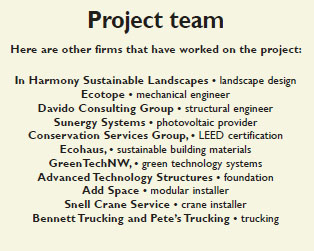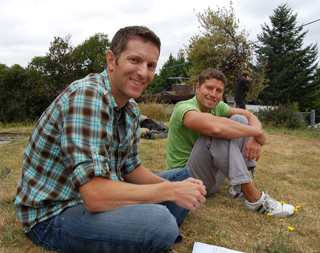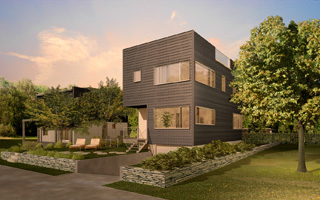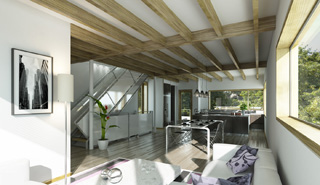|
Subscribe / Renew |
|
|
Contact Us |
|
| ► Subscribe to our Free Weekly Newsletter | |
| home | Welcome, sign in or click here to subscribe. | login |
Environment
| |
August 27, 2010
GreenFab bets modular green homes are the next big thing
Journal Staff Reporter
GreenFab, a Seattle-based developer of modular housing, recently broke ground on its first project: a prefab home in Jackson Place. GreenFab wants the project to launch its effort to bring affordable, sustainable and well-designed modular housing to Seattle.
GreenFab was founded in January of 2008 by longtime friends Johnny Hartsfield and Swen Grau. Both have real skin in the game, putting their personal assets on the line to start the firm. Grau also moved his family from Switzerland to Seattle, paying more than $10,000 for a visa and jumping through innumerable hoops. But they are confident this is the right time and the right product.
Hartsfield said the goal is to provide people with green housing at an affordable price. Though modular housing is gaining popularity, he said other providers approach it as a design problem. He said GreenFab will focus on solving customers problems.
“Green is always expensive and complicated,” Grau said. “It's just a way to make it simple. It should be simple.”
The demonstration project is at 1827 S. Lane St., and will be a home for Rob Humble of Hybrid Architecture, architect on the project. Hybrid Assembly is general contractor.
The 1,635-square-foot home is targeting LEED for homes platinum, Built Green five-star certification, Energy Star certification and net-zero energy. Total cost, including land, is $415,000.
Growing GreenFab
Hartsfield said the inspiration for the company came from his feelings of anger, sadness and frustration about traditional development. He grew up playing in the woods around Snohomish, but as an adult he saw the trees cut down and habitat destroyed to create poorly built tract homes. He moved to Seattle, but the destruction left a big impression. “It drove me crazy, it just killed me.”
In Ballard, he worked at landscape architecture firms but was frustrated by the limits put on him by traditional development and tight budgets. Badly designed and badly built townhouse projects in his neighborhood led Hartsfield to quit his job and start researching modular housing.
“I was welled up with energy and creativity and anger, and wanted to do something,” he said. “I want to provide homes for people in the urban environment that are more affordable so they have more options... so they don't have to move out to Snohomish.”
Grau said he wants GreenFab to strengthen the relationship between people and their houses. “It's part of your life, you have a relationship with it.”
The idea of GreenFab evolved over time, crystallizing at a design charette last summer where experts gathered to discuss ideas for a demonstration project. Experts included Judith Heerwagon of J.H. Heerwagen & Associates, Christopher Meek of the University of Washington's Integrated Design Lab, Jon Alexander of Sunshine Construction, George Ostrow of Velocipede Architects and representatives from Guerdon Enterprises of Boise, the modular manufacturer.
Working with Guerdon was tough initially, Hartsfield said, because the project required a new way of working. After the charette, the team continued developing designs but it still needed an actual project. About six months ago, Humble of Hybrid bought a small lot and asked if GreenFab wanted to use it for the demonstration project.
The first home
Humble's house should be complete in October, about 45 days after the six modules arrive. It will be open to the public for at least a month and there will also be public tours.
There will be two levels of living space above a 170-square-foot garage and a mother-in-law space with a separate entry, kitchen and bath. The house will have three bedrooms, 2 3/4 baths, a rooftop deck and an urban farming area in the backyard with compost space and room for chickens.
The upper floors will have movable walls so residents can easily create the space they need. Another buyer using the same house model could convert the mother-in-law space into a studio or office.
Green features include a hybrid heat pump water heater that will capture cool and warm temperatures from the air, converting it to heat water. It will have an energy recovery ventilator and backup electric heaters to heat bedrooms in winter.
An 800-gallon tank will collect rainwater for flushing toilets and irrigation. A 2.4-kilowatt solar canopy will help provide energy. The structure will be made of advanced framing with studs that are 24 inches apart rather than 16, an insulated concrete foundation for greater energy efficiency and an interactive system to track energy consumption. All concrete currently on the site will be recycled into retaining walls.
GreenFab wants to develop a line of pre-designed homes and work with clients to customize them. It will likely develop designs for 30, 40 and 50-foot lots. All GreenFab homes will target at least LEED for homes gold and four-star Built Green. Hartsfield said the model is easily scalable and can grow over time.
Grau said GreenFab wants to keep its homes affordable so more people can buy one and live green. The cost will vary depending on land, size, certifications and amenities. At the low end, GreenFab is aiming for $125 to $150 per square foot. The demonstration home will cost $180 per square foot. Of that, modular factory costs made up $95 per square foot. The land cost $156,000.
GreenFab will provide design and construction management, sales and marketing services for other developers. It could consult on large developments and has already been approached by developers that want to do green, modular projects. Hartsfield and Grau say their overall goal is to revolutionize the housing market. Though the first line of houses are meant for the Pacific Northwest, they want to develop designs for other ecoregions.

“I think we're going to make an impact anywhere we can,” Hartsfield said.
Hartsfield isn't sure if he will only do urban infill or if he will eventually build in forested areas that first set him on his journey. Ethically, he says he does not want to support development in forested land but knows it will happen no matter what. He's still weighing the pros and cons.
For now, GreenFab is launching a blog and is relaunching its website. It recently opened an office in the Phinney Neighborhood Center.
By working with Grau and pursuing something both men are passionate about, Hartsfield feels like he's in the right place.
“It's a dream come true. We've been waiting 16 years for this,” he said. “Literally, this feels like my life and our lives are making sense all of a sudden.”
Katie Zemtseff can be
reached by email or by phone
at (206) 622-8272.





